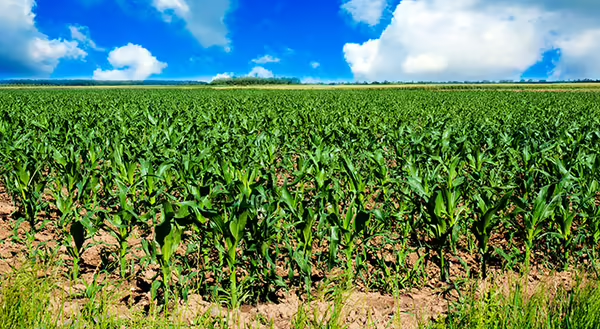
This blog post is the second in a two-part series analyzing a United States Department of Agriculture Economic Research Service (USDA-ERS) report on the adoption of conservation practices in agriculture by farmland owners and tenant farmers. The first post studied the current landscape of farmland tenure across the United States and Illinois and defined the different types of conservation practices that producers can implement on their operations. This post will investigate the trends in the adoption of conservation practices on owner-operator, cash-rented, and share-rented land. The ERS report breaks down the adoption of these conservation practices by crop and the regions that grow those crops. This post will only look at corn and soybean production data in the USDA Heartland region, which covers nearly all of Illinois. The analysis of each crop looks at two primary conservation practices: the percentage of acres utilizing cover crops and the Soil Tillage Intensity Rating (STIR) value, which indicates the level of tillage employed. STIR values range from 0 to 200, with lower values indicating less soil disturbance. A value less than 80 indicates some conservation tillage practice is being utilized. This post will also use data from the Illinois Nutrient Loss Reduction Strategy survey conducted by the USDA National Agricultural Statistic Service (NASS) to compare data from the Heartland region to data from Illinois.
As of 2021, the Heartland region accounted for approximately 60% of all corn production in the United States. The percentage of acres utilizing cover crops is similar across the three tenure categories. Almost 11% of share-rented acres adopted cover crops, compared to 10% of cash-rented acres and 9.9% of owner-operated acres. This suggests that, in the Heartland region, there is no difference in the adoption of cover crops among owner-operators and tenant operators. In contrast, there is a difference in STIR values across the three categories. Cash-rented acres had the lowest average STIR value of 43.37, with share-rented (48.89) and owner-operated acres (49.62) having higher values. While there is a difference, these values indicate that owner-operators and tenant operators use conservation tillage practices on their acres. Overall, the data highlights that, among corn acres, conservation tillage practices and cover crops are similarly adopted across different tenure categories in the Heartland region. How do these numbers compare to corn acres in Illinois? For the 2023 crop year in Illinois, 550,000 corn acres were planted after cover crops. This represents a 100,000-acre increase from 2021 and is approximately 38% of all cover crop acres in 2023.
As of 2018, the Heartland region accounted for 61% of all soybean production in the United States. There is little variation in the adoption of cover crops across the three tenure categories. Approximately 7.3% of owner-operated soybean acres utilized cover crops, compared to 7.5% of cash-rented acres and 5.2% of share-rented acres. There is slightly more variation among the three tenure categories when considering the use of conservation tillage practices. Share-rented acres had the lowest average STIR value (40.55), the average value for owner-operated acres was 43.36, and the average value for cash-rented acres was 49.14. This shows that all three tenure categories utilize conservation tillage practices on their operations. The Illinois Nutrient Loss Reduction Strategy survey data shows that 790,000 acres of soybeans were planted after a cover crop in 2023. That is a 100,000-acre decrease from 2021 and nearly 55% of all cover crop acres in Illinois.
This two-part blog series analyzed a USDA ERS report on the adoption of conservation practices by farmland owner-operators and tenants. The report found that, in the Heartland region, there was not much difference between owner-operators, cash renters, and share renters in adopting conservation practices such as conservation tillage and cover crops. Many factors influence whether a tenant operator will adopt conservation practices on the acres they rent. These factors include their relationship with the owner of the farmland, any stipulations in the rental agreement between the owner and tenant, the tenant’s ability to implement a specific practice, and even government programs to help support the implementation of certain practices. Considering all these factors, farmland owners and tenants looking to adopt conservation practices need to have open lines of communication and discuss what can be done to get these practices going. The push towards more conservation practices in agriculture is not going away as more emphasis is placed on being more environmentally and economically sustainable for the future.